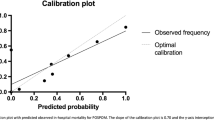Abstract
Introduction
Patients undergoing laparotomy for emergency general surgery (EGS) conditions, constitute a high-risk group with poor outcomes. These patients have a high prevalence of comorbidities. This study aims to identify patient factors, physiological and time-related factors, which place patients into a group at increased risk of mortality.
Methodology
In a retrospective analysis of all patients undergoing an emergency laparotomy at Greys Hospital from December 2012 to 2018, we used decision tree discrimination to identify high-risk groups.
Results
Our cohort included 1461 patients undergoing a laparotomy for an EGS condition. The mortality rate was 12.4% (181). Nine hundred and ten patients (62.3%) had at least one known comorbidity on admission. There was a higher rate of comorbidities among those that died (154; 85.1%). Patient factors found to be associated with mortality were the age of 46 years or greater (p < 0.001), current tuberculosis (p < 0.001), hypertension (p = 0.014), at least one comorbidity (0.006), and malignancy (0.033). Significant physiological risk factors for mortality were base excess less than −6.8 mmol/L (p < 0.001), serum urea greater than 7.0 mmol/L (p < 0.001) and waiting time from admission to operation (p = 0.014). In patients with an enteric breach, those younger than 46 years and a Shock Index of more than 1.0 were high-risk. Patients without an enteric breach were high-risk if operative duration exceeded 90 min (p = 0.004) and serum urea exceeding 7 mmol/dl (p = 0.016).
Conclusion
In EGS patients, patient factors as well as physiological factors place patients into a high-risk group. Identifying a high-risk group should prompt consideration for an adjusted approach that ameliorates outcomes.




Similar content being viewed by others
References
Vester-Andersen M, Lundstrom LH, Moller MH et al (2014) Mortality and postoperative care pathways after emergency gastrointestinal surgery in 2904 patients: a population-based cohort study. Br J Anaesth 112:860–870. https://doi.org/10.1093/bja/aet487
Bergenfelz A, Søreide K (2014) Improving outcomes in emergency surgery. Br J Surg. https://doi.org/10.1002/bjs.9347
Tengberg LT, Cihoric M, Foss NB et al (2017) Complications after emergency laparotomy beyond the immediate postoperative period–a retrospective, observational cohort study of 1139 patients. Anaesthesia 72:309–316. https://doi.org/10.1111/anae.13721
Saunders DI, Murray D, Pichel AC et al (2012) Variations in mortality after emergency laparotomy: the first report of the UK emergency laparotomy network. Br J Anaesth 109:368–375. https://doi.org/10.1093/bja/aes165
Stewart B, Khanduri P, McCord C et al (2014) Global disease burden of conditions requiring emergency surgery. Br J Surg 101:9–22. https://doi.org/10.1002/bjs.9329
Knowlton LM, Banguti P, Chackungal S et al (2017) A geospatial evaluation of timely access to surgical care in seven countries. Bull World Health Organ 95:437–444. https://doi.org/10.2471/blt.16.175885
Ball CG, Hameed SM, Brenneman FD (2010) Acute care surgery: a new strategy for the general surgery patients left behind. Can J Surg 53:84–85
Chovanes J, Cannon JW, Nunez TC (2012) The evolution of damage control surgery. Surg Clin North Am 92:859–875. https://doi.org/10.1016/j.suc.2012.04.002
Rotondo MF, Schwab CW, McGonigal MD et al (1993) ‘Damage control’: an approach for improved survival in exsanguinating penetrating abdominal injury. J Trauma–Inj Infect Crit Care 35:375–383
Sohn M, Iesalnieks I, Agha A et al (2018) Perforated diverticulitis with generalized peritonitis: low stoma rate using a “damage control strategy.” World J Surg 42:3189–3195. https://doi.org/10.1007/s00268-018-4585-y
Waibel BH, Rotondo MF (2012) Damage control for intra-abdominal sepsis. Surg Clin North Am 92:243–257. https://doi.org/10.1016/j.suc.2012.01.006
Khan A, Hsee L, Mathur S, Civil I (2013) Damage-control laparotomy in nontrauma patients: review of indications and outcomes. J Trauma Acute Care Surg 75:365–368. https://doi.org/10.1097/TA.0b013e31829cb65e
Smith MTD, Bruce JL, Clarke DL (2021) Health-related behaviours, HIV and active tuberculosis are associated with perioperative adverse events Following emergency laparotomy at a tertiary surgical service in KwaZulu-Natal, South Africa. World J Surg 45:1672–1677. https://doi.org/10.1007/s00268-021-05986-9
Hernandez MC, Kong VY, Aho JM et al (2017) Increased anatomic severity in appendicitis is associated with outcomes in a South African population. J Trauma Acute Care Surg 83:175–181. https://doi.org/10.1097/TA.0000000000001422
Smith MTD, Clarke DL (2021) Spectrum and outcome of emergency general surgery laparotomies at a tertiary center in South Africa. J Surg Res 262:65–70. https://doi.org/10.1016/j.jss.2020.12.062
Berger T, Green J, Horeczko T et al (2013) Shock index and early recognition of sepsis in the emergency department: pilot study. West J Emerg Med 14:168–174. https://doi.org/10.5811/westjem.2012.8.11546
Becher RD, Hoth JJ, Miller PR et al (2012) Systemic inflammation worsens outcomes in emergency surgical patients. J Trauma Acute Care Surg 72:1140–1149. https://doi.org/10.1097/TA.0b013e3182516a97
Tolstrup MB, Watt SK, Gögenur I (2017) Morbidity and mortality rates after emergency abdominal surgery: an analysis of 4346 patients scheduled for emergency laparotomy or laparoscopy. Langenbeck’s Arch Surg 402:615–623. https://doi.org/10.1007/s00423-016-1493-1
Ng-Kamstra JS, Dare AJ, Patra J et al (2015) Deaths from acute abdominal conditions and geographic access to surgical care in India: a nationally representative population-based spatial analysis. Lancet 385:S32. https://doi.org/10.1016/s0140-6736(15)60827-3
Ramsay G, Wohlgemut JM, Jansen JO (2019) Twenty-year study of in-hospital and postdischarge mortality following emergency general surgical admission. BJS Open 3:713–721. https://doi.org/10.1002/bjs5.50187
Godat L, Kobayashi L, Costantini T, Coimbra R (2013) Abdominal damage control surgery and reconstruction: world society of emergency surgery position paper. World J Emerg Surg. https://doi.org/10.1186/1749-7922-8-53
Funding
No external or internal funding was utilized to generate this work.
Author information
Authors and Affiliations
Contributions
MTD Smith: primary investigator and author, data analysis and table preparation. DL Clarke assisted with the conceptualization and planning of the study and assisted with the writing of the manuscript. Dr. JL Bruce: Conceptualization of manuscript.
Corresponding author
Ethics declarations
Conflict of interest
The authors have no conflicts of interest to declare.
Additional information
Publisher's Note
Springer Nature remains neutral with regard to jurisdictional claims in published maps and institutional affiliations.
Rights and permissions
About this article
Cite this article
Smith, M.T.D., Bruce, J.L. & Clarke, D.L. Using Machine Learning to Establish Predictors of Mortality in Patients Undergoing Laparotomy for Emergency General Surgical Conditions. World J Surg 46, 339–346 (2022). https://doi.org/10.1007/s00268-021-06360-5
Accepted:
Published:
Issue Date:
DOI: https://doi.org/10.1007/s00268-021-06360-5




